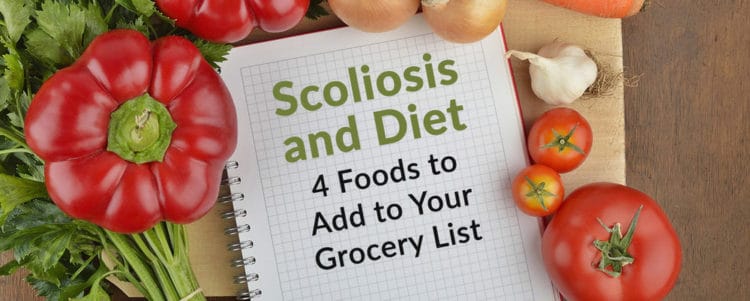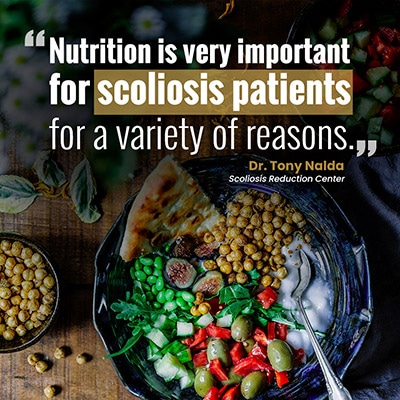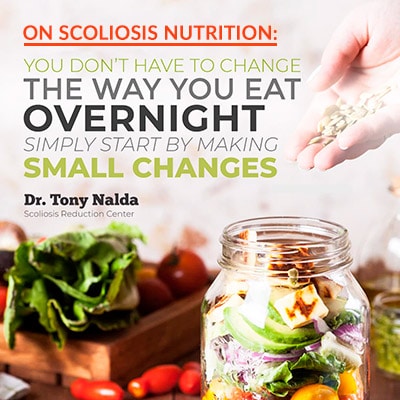
To the average person, a special scoliosis diet may not seem necessary. But for those who are faced with a scoliosis diagnosis, diet becomes an important factor for recovery, building strength, living with more energy and improving overall health and wellness. A properly calibrated diet will not heal scoliosis or reduce curvature by itself; however, it will help create conditions within the body that are much more conducive to healing and the reduction of the negative aspects of scoliosis. And when the appropriate scoliosis diet is introduced along with a treatment plan that focuses on strengthening the spine and improving function, it can have a tremendous positive impact.
Table of Contents
When I see scoliosis patients and develop plans for their treatment, I always address the condition from a structural standpoint first. Correcting the abnormal curvature of the spine is always my top priority, so we always get to work on the structural aspect of the condition right away. That being said, diet and nutrition enter the picture soon after we begin to address structural issues.

Nutrition is very important for scoliosis patients for a variety of reasons:
Convenience and cost have become the primary drivers of diet, particularly here in the United States. Bad nutrition has become part of the culture, and it has produced an unhealthy populace, in general.
Food items that are loaded with sugar, salt and unhealthy fats are cheap and easy to find. But they are the enemy of a proper scoliosis diet!
Some examples of foods scoliosis patients should avoid include:

For many people, the items and ingredients listed above will be difficult to remove from the diet, which is understandable, given their availability and popularity. But switching to a healthier diet is well worth the effort.
I suggest making dietary switches slowly, at first. Psychologically speaking, it’s easier for people to deal with gradual changes than an abrupt and complete overhaul of the diet. It also increases the likelihood that dietary changes will become permanent.
Now that I’ve listed foods that should not be consumed by those with scoliosis, let’s get to the good stuff!
The following food items provide excellent nutrition and improve the body’s ability to recover successfully from scoliosis. They promote greater strength, stamina and energy, which helps scoliosis patients build more active and capable bodies. And they are excellent for everyone, regardless of whether they deal with scoliosis or not — the whole family can get on board!
#1 — Fresh Fruits and Vegetables
Fresh fruits and vegetables are packed with nutrients that are crucial for the health and maintenance of the human body. They also contain fiber, which is something that’s sorely lacking from most diets. Additionally, the consumption of fresh fruits and vegetables can contribute to a reduced risk of chronic diseases.
The list of healthy fruits and vegetables is a long one, but here are some items you can add to your cart the next time you go grocery shopping:
Remember — these items should be purchased fresh, not frozen. However, frozen vegetables are better for the body than anything on the list of foods to avoid. Also, juicing fruits is not as healthy as you might think. Juicing removes fiber and concentrates sugars. And if you buy pre made juices, chances are they are loaded with added sugar, too.
Not sure what to do with all these fruits and veggies? The internet is full of healthy recipes that bring out the best of these items. Fruits and veggies also make great snacks, especially when paired with healthy hummus or nut butters!
#2 — Non Processed Meats
Chicken, turkey, beef, fish and other meats provide essential protein to the body. Just be sure to avoid oily or fried meats, like those you would get at a fast food restaurant. You should also steer clear of packaged lunch meats and pork, which contain preservatives and other unhealthy add ons.
#3 — Foods Containing Calcium and Vitamin D
Calcium is a highly important mineral in the human body, and it’s crucial for scoliosis patients to introduce into their diets via supplements or whole foods. Poppy, sesame, celery and chia seeds all contain high amounts of calcium (in addition to super-healthy proteins and fats). Beans and lentils also contain calcium, as well as a number of other important minerals. If you’re looking for a healthy snack, almonds are excellent, too.
Vitamin D is also crucial, largely because many people do not get enough of it. Supplements are helpful, but vitamin D can also be found in several foods, including fish, eggs and mushrooms.
#4 — Water
While it is not technically a food, water is critical in the ideal scoliosis diet. Proper hydration keeps all the body’s systems in top working order, and it aids in most of the body’s natural processes.
Water is also the perfect substitute for soda, coffee, alcoholic beverages and other unhealthy drinks. I suggest increasing your consumption of water by keeping a bottle or glass of it near you at all times. It quenches thirst better than soda, and it can even stave off hunger pangs that might otherwise lead you to eating unhealthy snacks!

I get that changing your family’s diet may seem impossible if you’re accustomed to eating certain foods regularly. But the benefits of altering your nutrition are profound. You don’t have to change the way you eat overnight; simply start by making small changes. You or your child will feel better and more motivated to make further changes, which will boost energy and strength. Doing so will also significantly impact you or your child’s ability to treat scoliosis effectively.
